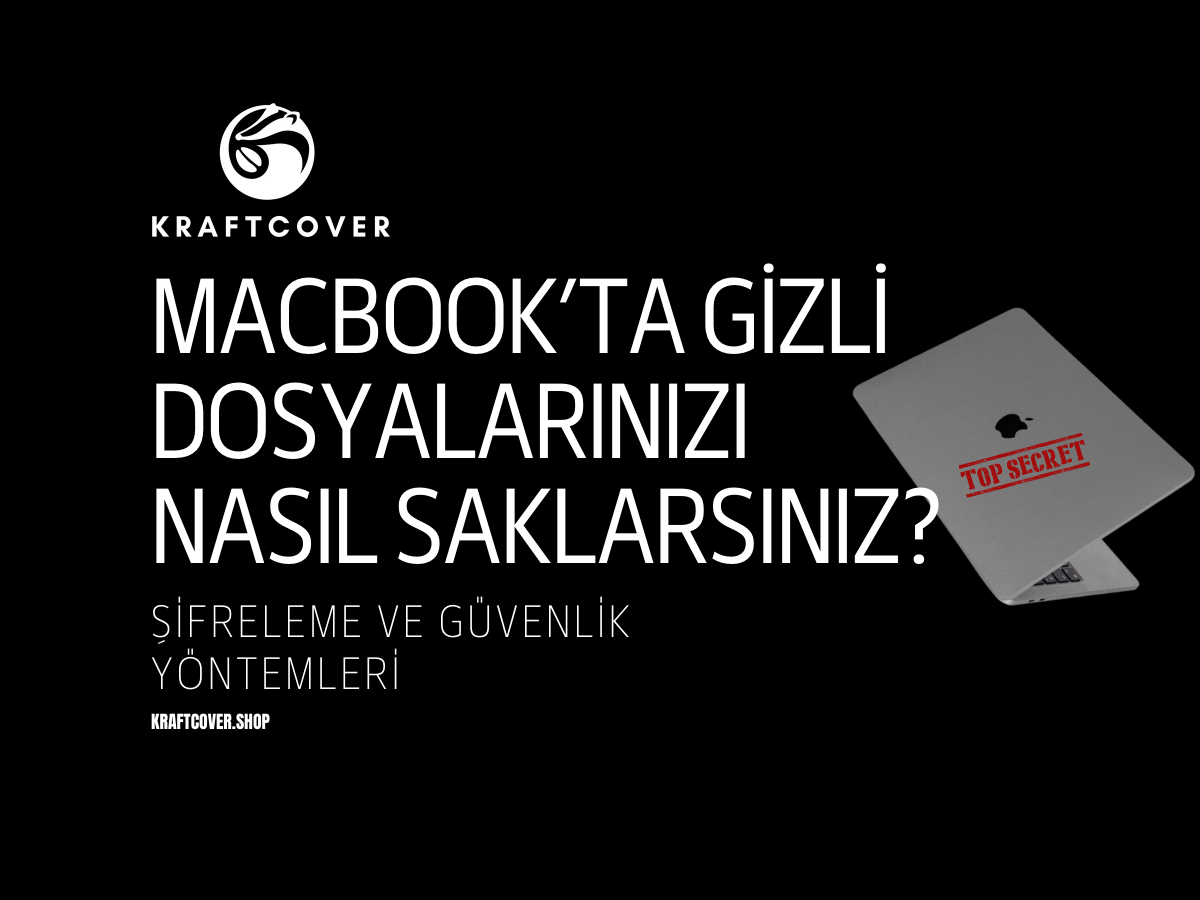MacBook’unuzda sakladığınız hassas bilgiler, özel belgeler veya kişisel fotoğraflar, yanlış ellere geçtiğinde ciddi sorunlara yol açabilir. Neyse ki macOS, verilerinizi güvende tutmanız için çeşitli araçlar sunuyor. Gizli dosyalarınızı korumak, yalnızca güvenliğinizi artırmakla kalmaz, aynı zamanda iş akışınızı daha rahat ve endişesiz bir şekilde sürdürebilmenizi sağlar.
Bu yazıda, dosyalarınızı nasıl güvenli hale getirebileceğinizi ve koruyabileceğinizi adım adım açıklıyoruz.
Disk İzlencesi ile Şifreli Disk Görüntüsü Oluşturma

macOS’un yerleşik "Disk İzlencesi" uygulaması, hassas dosyalarınızı şifrelemek için oldukça etkili bir yöntemdir. Bu sanal disk görüntüleri, bir şifre belirleyerek yalnızca yetkili kişilerin erişimini sağlar.
Adım Adım Şifreli Disk Görüntüsü Oluşturma:
- Disk İzlencesini Açın: Spotlight arama çubuğuna "Disk İzlencesi" yazarak uygulamayı açın.
- Yeni Disk Görüntüsü Oluşturun: Disk İzlencesi’nde "Dosya" menüsünden "Yeni Görüntü" seçeneğine, ardından "Boş Görüntü"ye tıklayın.
- Disk Görüntüsünü Ayarlayın: Bu adımda, disk görüntüsüne bir isim verin ve boyutunu belirleyin. Dosyalarınızın toplam boyutunu göz önünde bulundurmak önemlidir; gerekirse daha büyük bir alan seçebilirsiniz.
- Şifreleme Seçenekleri: "Şifreleme" bölümünde "128-bit AES" veya "256-bit AES" şifrelemeyi seçin. Güçlü bir şifreleme, verilerinizin güvenliğini artıracaktır.
- Şifre Belirleyin: Disk görüntüsünü şifrelemek için bir şifre belirlemeniz istenir. Güçlü, tahmin edilmesi zor bir şifre seçin. Şifrenizi kaydedin; aksi takdirde bu alandaki dosyalarınıza erişiminizi kaybedebilirsiniz.
- Kullanıma Hazır: Şifreli disk görüntüsü masaüstünüzde bir sürücü gibi görünür. Dosyalarınızı bu alana taşıyabilirsiniz. Disk görüntüsünü kapattığınızda, yalnızca şifre ile erişilebilir hale gelir.
Bu yöntem, özellikle hassas finansal belgeler, iş dosyaları veya kişisel fotoğraflar gibi gizlilik gerektiren veriler için oldukça etkilidir.
Terminal ile Gizli Klasör Oluşturma
MacBook’unuzda belirli dosyaları gizlemek istiyorsanız, Terminal’i kullanarak bu dosyaları Finder’da görünmez hale getirebilirsiniz. Bu yöntem, dosyalarınızı göz önünden uzak tutar, ancak tam güvenlik sağlamadığını unutmamak gerekir.
Terminal ile Gizli Klasör Oluşturma:
- Terminal’i Açın: Spotlight arama çubuğuna "Terminal" yazarak uygulamayı başlatın.
- Gizli Klasör Oluşturma: Terminal penceresine aşağıdaki komutu yazın ve Enter tuşuna basın:
mkdir ~/.gizli_klasorum
Bu komut, ev dizininizde ".gizli_klasorum" adında bir klasör oluşturur. Nokta (.) ile başlayan klasörler Finder’da görünmez hale gelir.
- Dosyaları Gizli Klasöre Taşıyın: Finder’ı kullanarak gizlemek istediğiniz dosyaları bu klasöre taşıyabilirsiniz.
- Gizli Dosyaları Görüntüleme: Gizli dosyaları görmek istediğinizde, Terminal’e şu komutu yazın:
defaults write com.apple.finder AppleShowAllFiles true
Ardından Finder’ı yeniden başlatmak için:
killall Finder
Bu işlem, Finder’da tüm gizli dosyaları görünür hale getirir. Dosyaları tekrar gizlemek için, yukarıdaki "true" ifadesini "false" ile değiştirip komutu yeniden çalıştırın.
Bu yöntem, hızlı ve pratik bir gizleme yöntemi olsa da tam güvenlik sağlamaz. Daha fazla güvenlik için şifreleme yöntemlerini de kullanmalısınız.
3. FileVault ile Disk Şifreleme

FileVault, macOS’un sunduğu en güçlü güvenlik araçlarından biridir. Tüm diskinizi şifreleyerek, verilerinize yalnızca doğru şifre ile erişilmesini sağlar. Özellikle MacBook’unuzun çalınması veya kaybolması durumunda dosyalarınızın güvende kalmasını sağlar.
FileVault’u Etkinleştirme:
- Sistem Ayarları: Apple Menüsü > Sistem Ayarları > Güvenlik ve Gizlilik yolunu izleyin.
- FileVault Sekmesi: FileVault sekmesine geçin ve "FileVault’u Aç" butonuna tıklayın.
- Şifreleme Süreci: Şifreleme süreci, diskinizin boyutuna bağlı olarak biraz zaman alabilir. Bu nedenle, bu işlemi gerçekleştirirken MacBook’unuzu açık tutmanız gerekir. FileVault, MacBook’unuzu yeniden başlatırken ya da uyandırırken şifre gerektirerek verilerinizi korur.
Not: FileVault’un güvenlik avantajlarından yararlanmak için düzenli yedekleme yapmayı unutmayın.
4. Üçüncü Parti Uygulamalar ile Ek Güvenlik
macOS’un yerleşik özelliklerine ek olarak, üçüncü parti uygulamalarla dosyalarınızı ve klasörlerinizi daha güvenli hale getirebilirsiniz. Bu uygulamalar, özellikle gizlilik gerektiren verileri saklarken ek güvenlik sağlar.
Önerilen Güvenlik Uygulamaları:
- VeraCrypt: Açık kaynaklı ve ücretsiz bir dosya şifreleme uygulaması olan VeraCrypt, dosyalarınızı şifreleyerek güvenli bir şekilde saklar. Harici depolama cihazlarını da şifrelemek için kullanabilirsiniz.
- Hider 2: Mac kullanıcılarına özel olarak geliştirilmiş bu uygulama, dosya ve klasörlerinizi şifreleyip görünmez hale getirir. Basit ve kullanıcı dostu bir arayüze sahiptir.
Bu uygulamalar, özellikle sürekli hareket halinde olanlar ve hassas verilerini güvende tutmak isteyenler için idealdir.
Her gün yolda olanlar için laptop çanta modelleri içeriğimize mutlaka göz atın!
5. Şifreli ZIP Dosyası Oluşturma
Belirli dosyalarınızı şifrelemek ve saklamak için ZIP dosyalarını şifreleyebilirsiniz. Bu yöntem, belirli bir dosya grubunu sıkıştırarak şifre korumalı bir şekilde saklamanızı sağlar.
Terminal ile Şifreli ZIP Dosyası Oluşturma:
- Terminal’i Açın: Spotlight ile Terminal’i açın.
- Komutu Girin: Aşağıdaki komut ile bir klasörü şifreli bir ZIP dosyasına dönüştürün:
zip -e şifreli_klasor.zip /dosya/yolu/klasor_adi
- Şifre Belirleyin: Bu komutu çalıştırdıktan sonra, oluşturulan ZIP dosyası için bir şifre belirleyin. Bu şifre olmadan dosyalarınız açılamaz.
Bu yöntem, dosyalarınızı sıkıştırarak saklamak için basit ve etkili bir çözümdür.
Güvenlik için Ek İpuçları
- Güçlü Şifreler Kullanın: Şifreleme yaparken güçlü ve tahmin edilmesi zor şifreler seçin. Özel karakterler ve rakamlar kullanarak şifrelerinizi güçlendirin.
- Düzenli Yedekleme Yapın: Herhangi bir veri kaybını önlemek için düzenli yedekleme yapın. Time Machine gibi macOS yedekleme araçlarını kullanabilirsiniz.
Sonuç
MacBook’unuzda gizli dosyalarınızı güvenli bir şekilde saklamak için pek çok yöntem mevcut. Disk İzlencesi ile şifreleme, Terminal ile gizleme, FileVault kullanımı ve üçüncü parti uygulamalar sayesinde, hassas bilgilerinizin başkalarının eline geçmesini engelleyebilirsiniz. Bu yöntemleri uygulayarak, gizliliğinizi ve verilerinizi en iyi şekilde koruyabilirsiniz.



